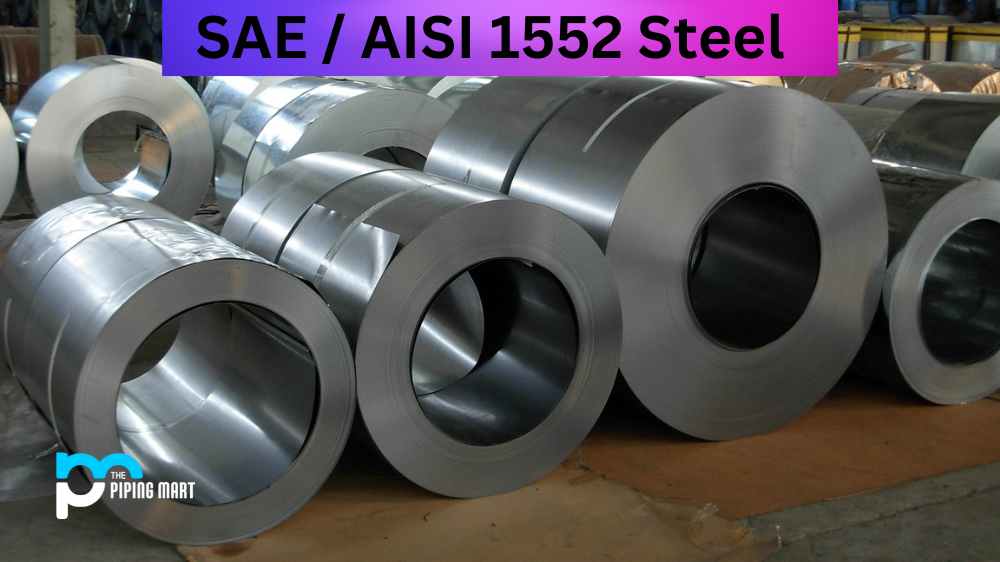If you’re looking for steel that offers superior corrosion, heat, and machining resistance, then SAE/AISI 1552 steel is the material to choose. This versatile alloy is used in multiple industries due to its excellent properties. SAE/AISI 1552 Carbon Steel, also known as UNS G15520, is a low carbon steel that is commonly used for manufacturing various parts and components. This steel has a unique composition that includes elements like iron, carbon, manganese, and silicon. With its exceptional weldability, machinability, and excellent strength-to-weight ratio, SAE-AISI 1552 steel is highly sought after in the manufacturing industry. Furthermore, it possesses good corrosion resistance and a smooth surface finish, making it ideal for use in a variety of applications. Thanks to its remarkable properties, UNS G15520 is a popular choice for industries ranging from automotive and construction to machinery and equipment manufacturing. Let’s take a closer look at the characteristics and uses of SAE/AISI 1552 Carbon Steel.
What Forms of AISI 1552 is Available at Piping Mart?
- Nut
- Bar
- Bolt
- Pipe
- Screw
- Tubing
- Valves
- Washers
- Flanges
- Fasteners
- Electrodes
- Stud Bolts
- Sheet Plates
- Pipe Fittings
- Forged Fitting
- Instrumentation Fittings
AISI 1552 Composition
AISI 1552 is a low-alloy carbon steel with a composition emphasizing carbon, manganese, and silicon. This combination contributes to its notable strength and durability. Its versatile nature makes it suitable for diverse applications, particularly in industries where high-strength materials are essential for structural components and machinery parts.
| Element | Content (%) |
|---|---|
| Iron, Fe | 97.86 – 98.33 |
| Manganese, Mn | 1.20 – 1.50 |
| Carbon, C | 0.470 – 0.550 |
| Sulfur, S | 0.0500 |
| Phosphorous, P | 0.0400 |
AISI 1552 Physical Properties
AISI 1552 exhibits a density of approximately 7.7-8.03 g/cm³, reflecting its mass per unit volume. This density, common in low-alloy carbon steels, influences the material’s overall weight and is a crucial factor in various applications, particularly where strength and weight considerations are essential, such as in structural components.
| Properties | Metric | Imperial |
|---|---|---|
| Density | 7.7-8.03 g/cm3 | 0.278-0.290 lb/in3 |
AISI 1552 Mechanical Properties
AISI 1552 demonstrates mechanical properties essential for engineering applications. Its elastic modulus, a measure of stiffness, typically ranges from 190 to 210 GPa. The Poisson’s ratio, indicating material deformation under stress, typically falls between 0.27 and 0.30. These properties contribute to the steel’s suitability for diverse structural and mechanical applications.
| Properties | Metric | Imperial |
|---|---|---|
| Elastic modulus | 190-210 GPa | 27557-30458 ksi |
| Poisson’s ratio | 0.27-0.30 | 0.27-0.30 |
AISI 1552 Uses
AISI/SAE 1552 is an exceptionally strong steel alloy. Allowing it to withstand temperatures up to 1600°C or 2900°F. This makes it an optimal choice for a variety of uses, such as jet engines, fasteners, nuclear power equipment and turbine blades that are often exposed to extraordinarily high temperatures. The material is also easily machinable and can be cut into different shapes, forming desired components with precision. Because of its strength and malleability characteristics, AISI/SAE 1552 has become a popular choice amongst industry professionals when creating functional and dependable car chassis and suspension components like springs, shocks, and stabilizers.
AISI 1552 Uses in Industries
- Automotive Industry
- Aerospace Industry
- Construction Industry
- Energy Sector
- Manufacturing Industry
AISI 1552 Corrosion Resistance
AISI 1552 Heat Resistance
Another notable benefit of SAE/AISI 1552 steel is its heat resistance. It can withstand high temperatures without becoming brittle or losing its formability. It is also resistant to thermal shock and can be used in applications that require cyclic variations in temperature without any significant loss in performance or strength. This makes it a great choice for parts exposed to extreme temperatures as well as those subject to frequent temperature fluctuations.
AISI 1552 Heat Treatment
AISI 1552 Machining
AISI 1552 Welding
SAE/AISI 1552 steel can be successfully welded using conventional welding techniques such as oxy-acetylene welding or metal inert gas welding (MIG). It should be preheated prior to welding in order to reduce cracking risk during subsequent cooling cycles; however, post-weld stress relief treatments are usually not required for this type of steel due to its inherent low levels of hardness after welding operations have been completed.
Conclusion
In short, SAE/AISI 1552 offers many benefits, including superior corrosion resistance, excellent heat resistance qualities, great machinability capabilities and easy weldability, making it an ideal choice for multiple applications across various industries needing strong yet pliable materials able to handle high temperatures and corrosive environments with ease whilst providing long-lasting performance no matter what the application requires!

Abhishek is a seasoned blogger and industry expert, sharing his insights and knowledge on various topics. With his research, Abhishek offers valuable insights and tips for professionals and enthusiasts. Follow him for expert advice on the latest trends and developments in the metal industry.




